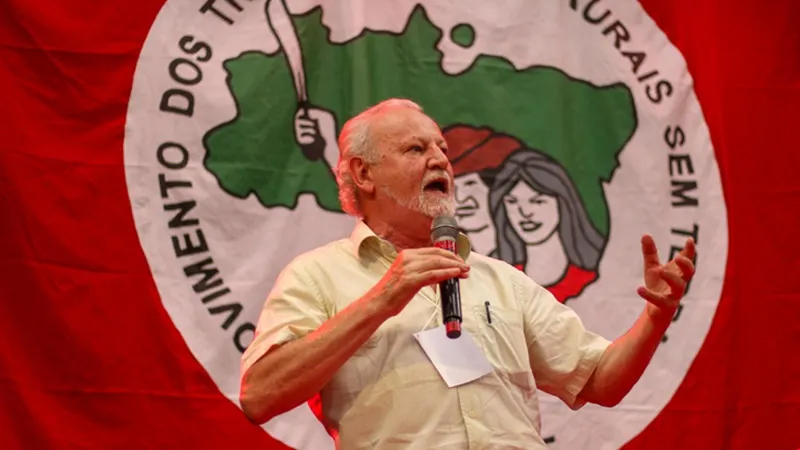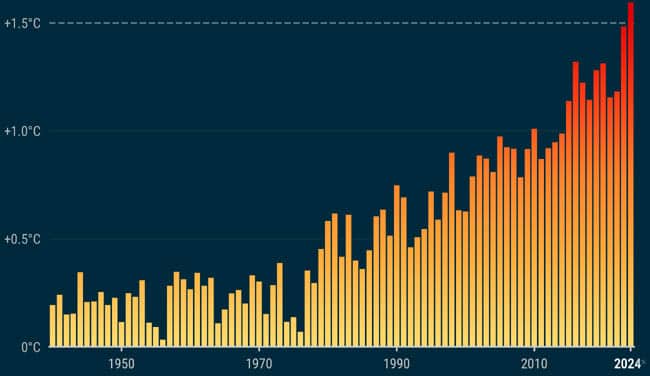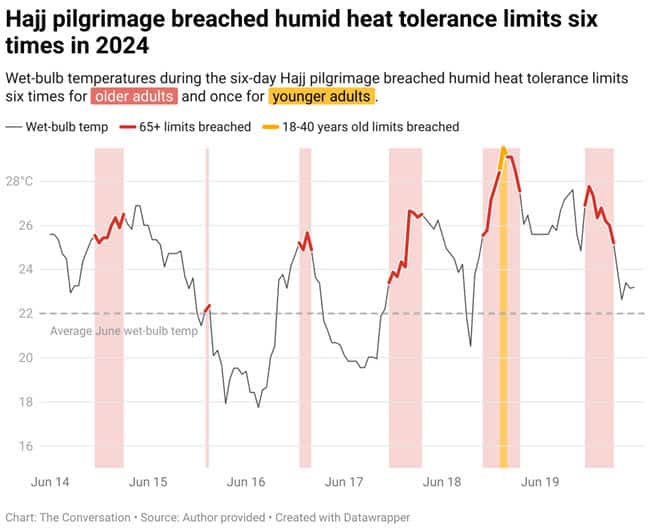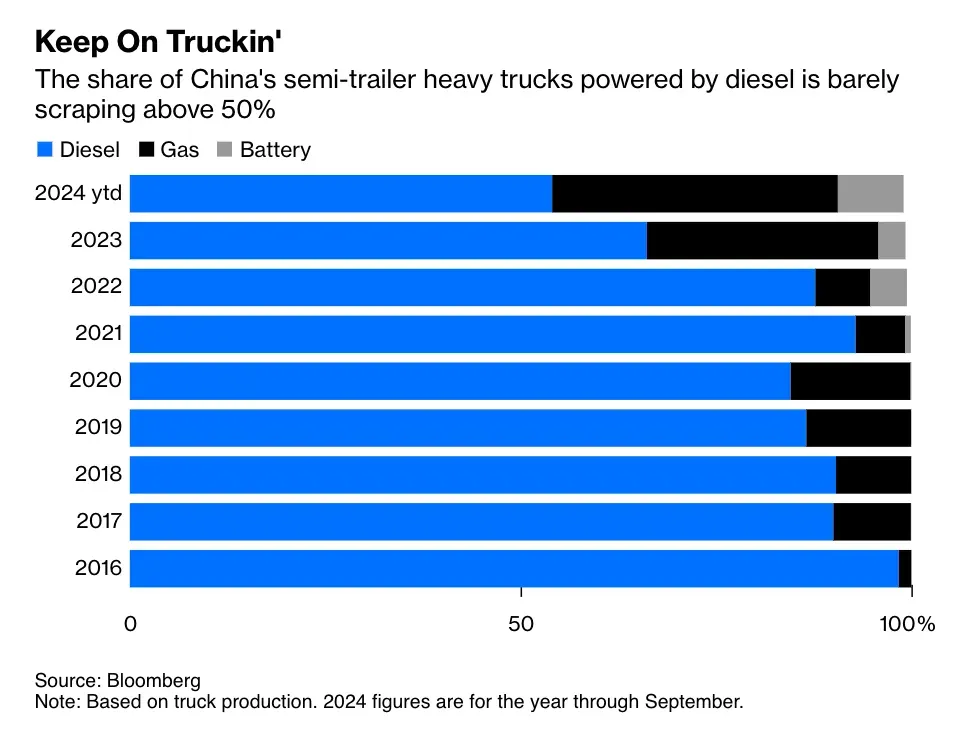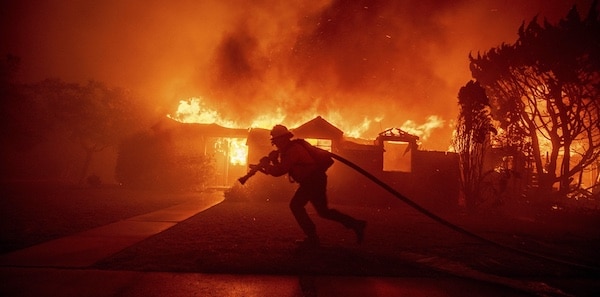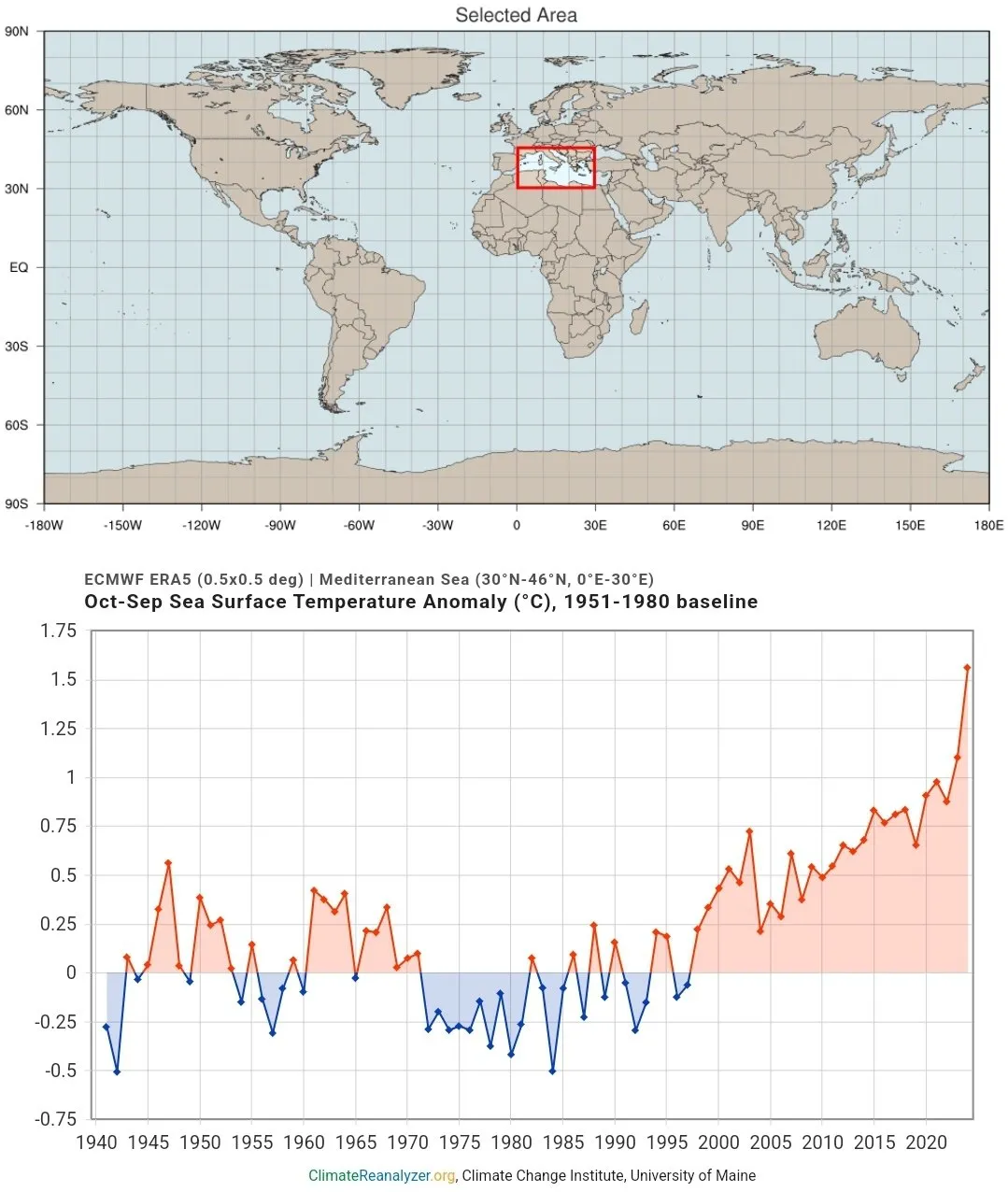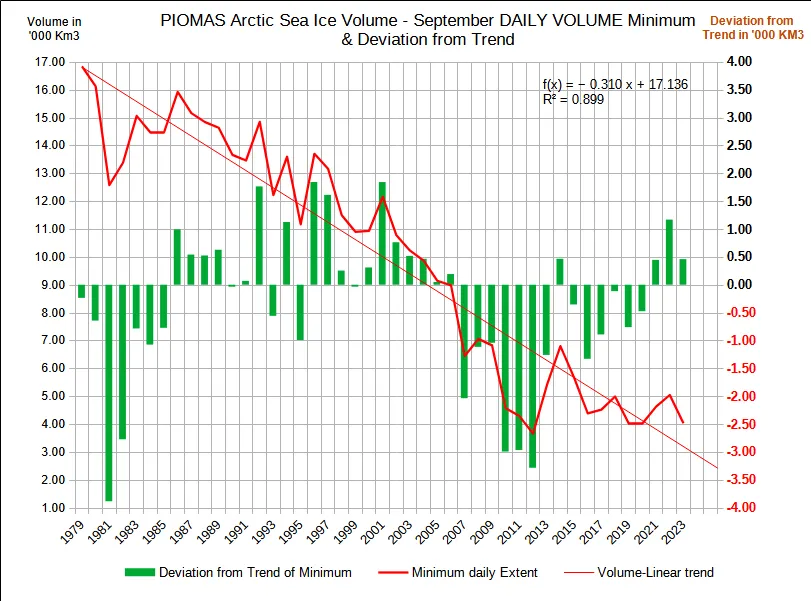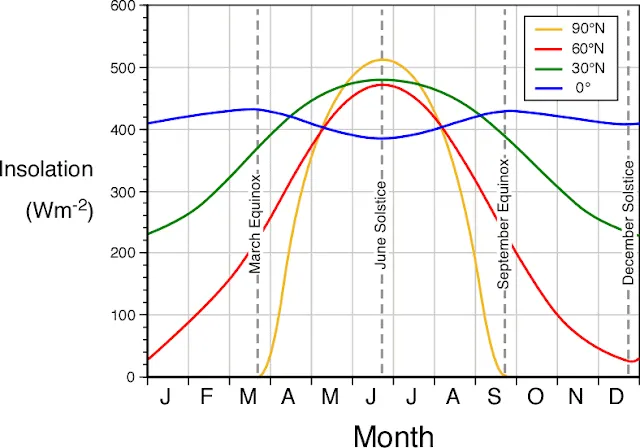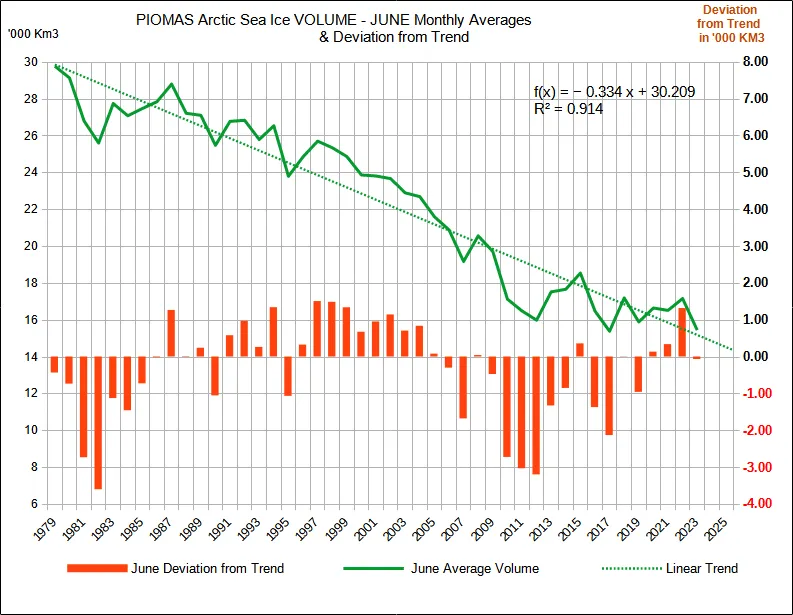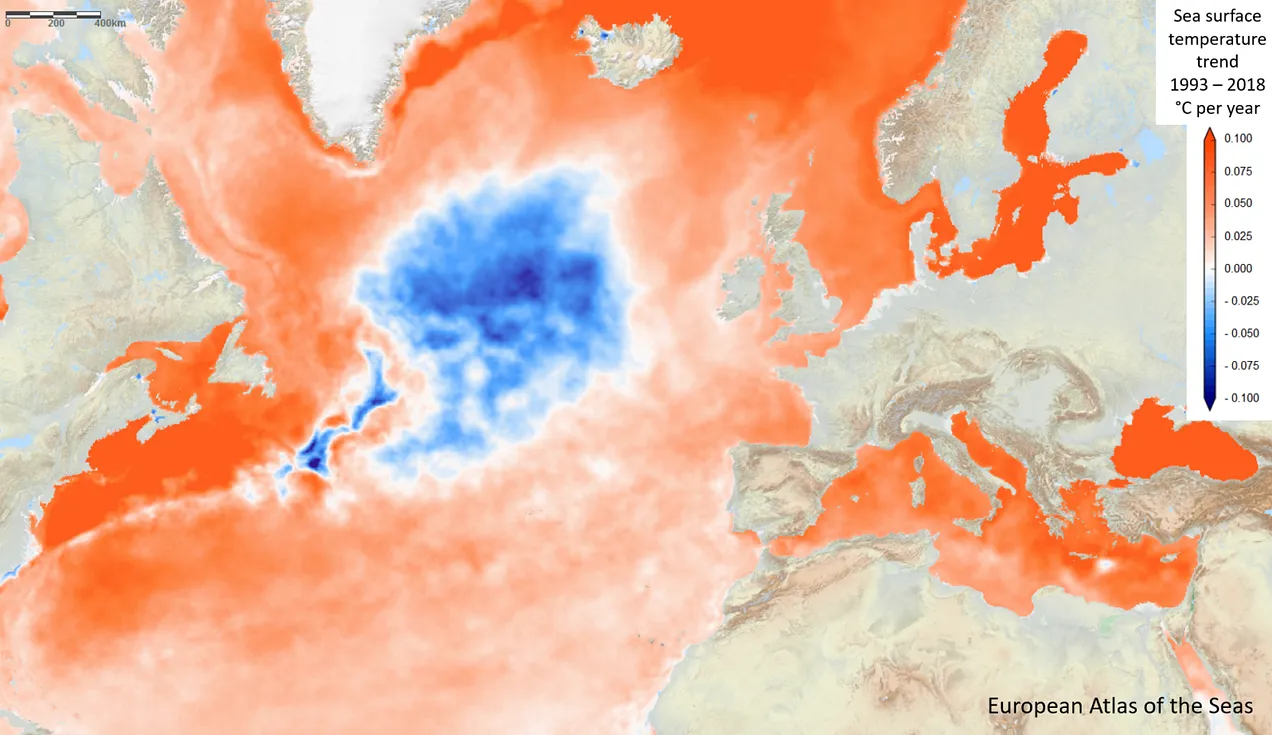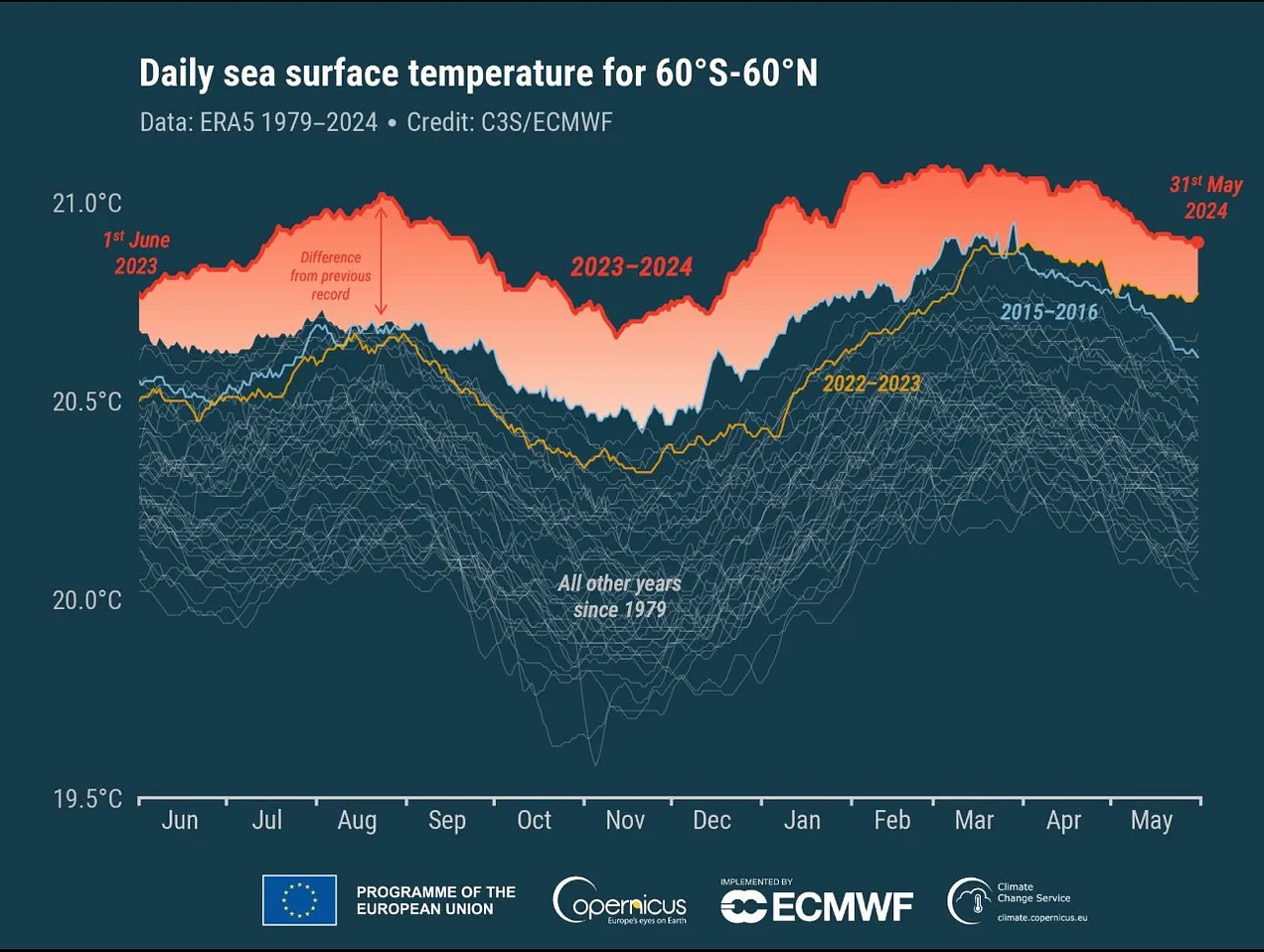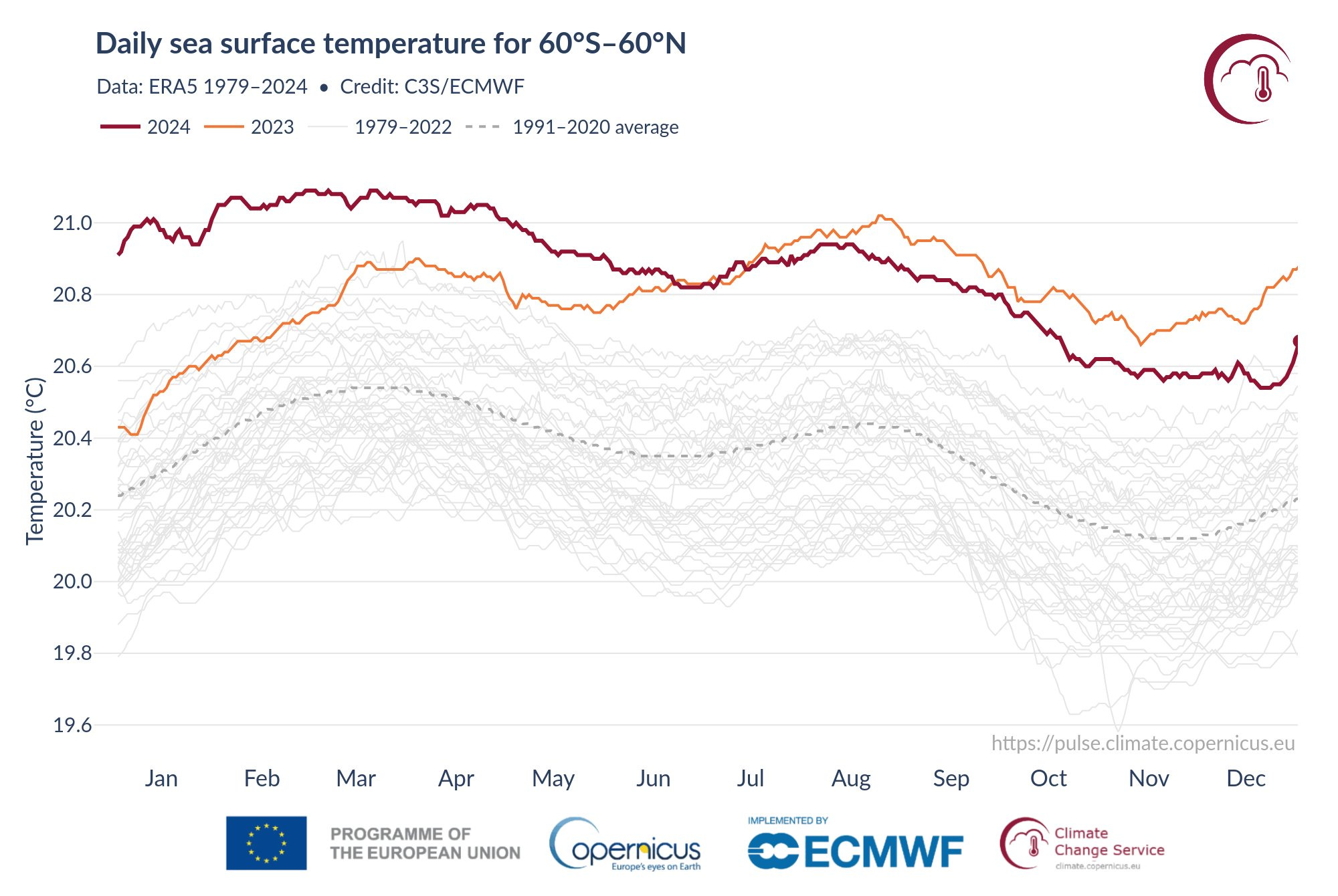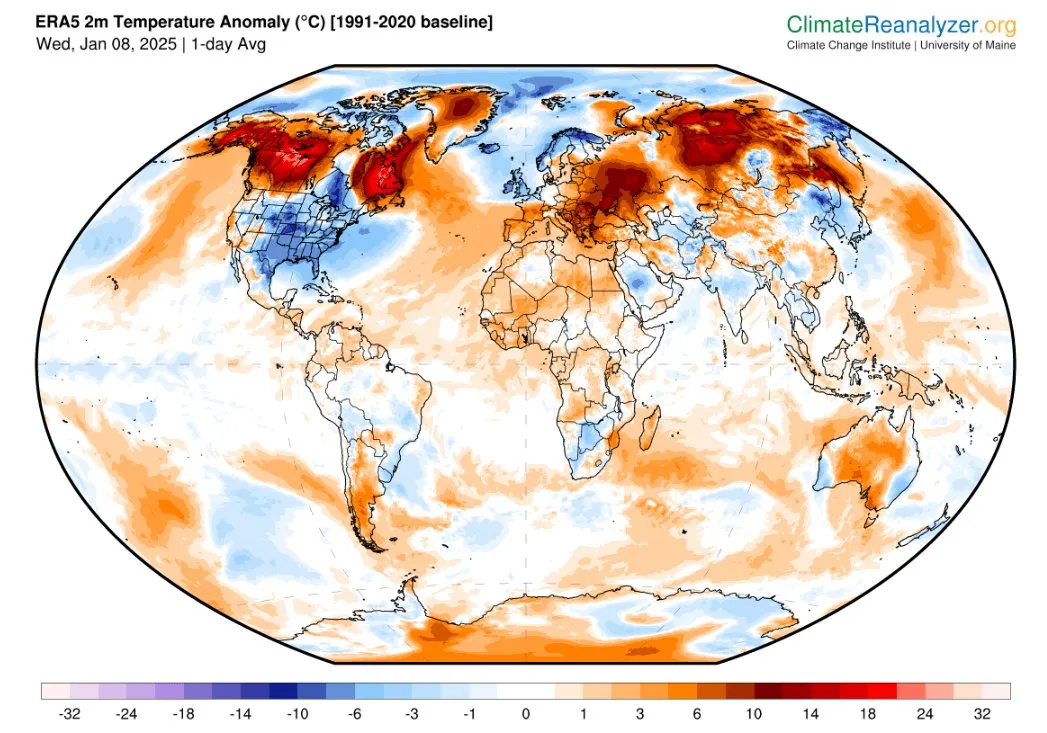December 10, 2024
Lancet study: Climate extremes are increasingly claiming lives and livelihoods worldwide

Excerpt from the Executive Summary of the 2024 Lancet Countdown report on health and climate change published November 9, 2024.
Despite the initial hope inspired by the 2015 Paris Agreement, the world is now dangerously close to breaching its target of limiting global multiyear mean heating to 1.5°C. Annual mean surface temperature reached a record high of 1.45°C above the pre-industrial baseline in 2023, and new temperature highs were recorded throughout 2024. The resulting climatic extremes are increasingly claiming lives and livelihoods worldwide.
The Lancet Countdown: tracking progress on health and climate change was established the same year the Paris Agreement entered into force, to monitor the health impacts and opportunities of the world’s response to this landmark agreement. Supported through strategic core funding from Wellcome, the collaboration brings together over 300 multidisciplinary researchers and health professionals from around the world to take stock annually of the evolving links between health and climate change at global, regional, and national levels.
The 2024 report of the Lancet Countdown, building on the expertise of 122 leading researchers from UN agencies and academic institutions worldwide, reveals the most concerning findings yet in the collaboration’s 8 years of monitoring.
Data in this year’s report show that people all around the world are facing record-breaking threats to their wellbeing, health, and survival from the rapidly changing climate. Of the 15 indicators monitoring climate change-related health hazards, exposures, and impacts, ten reached concerning new records in their most recent year of data.
Heat-related mortality of people older than 65 years increased by a record-breaking 167%, compared with the 1990s, 102 percentage points higher than the 65% that would have been expected without temperature rise.
Heat exposure is also increasingly affecting physical activity and sleep quality, in turn affecting physical and mental health. In 2023, heat exposure put people engaging in outdoor physical activity at risk of heat stress (moderate or higher) for a record high of 27.7% more hours than on average in the 1990s and led to a record 6% more hours of sleep lost in 2023 than the average during 1986–2005.
People worldwide are also increasingly at risk from life-threatening extreme weather events. Between 1961–90 and 2014–23, 61% of the global land area saw an increase in the number of days of extreme precipitation, which in turn increases the risk of flooding, infectious disease spread, and water contamination.
In parallel, 48% of the global land area was affected by at least 1 month of extreme drought in 2023, the second largest affected area since 1951.
The increase in drought and heatwave events since 1981–2010 was, in turn, associated with 151 million more people experiencing moderate or severe food insecurity across 124 countries assessed in 2022, the highest recorded value.
The hotter and drier weather conditions are increasingly favoring the occurrence of sand and dust storms. This weather-environmental phenomenon contributed to a 31% increase in the number of people exposed to dangerously high particulate matter concentrations between 2003–07 and 2018–22.
Meanwhile, changing precipitation patterns and rising temperatures are favoring the transmission of deadly infectious diseases such as dengue, malaria, West Nile virus-related illness, and vibriosis, putting people at risk of transmission in previously unaffected locations.
Compounding these impacts, climate change is affecting the social and economic conditions on which health and wellbeing depend. The average annual economic losses from weather-related extreme events increased by 23% from 2010–14 to 2019–23, to US$227 billion (a value exceeding the gross domestic product [GDP] of about 60% of the world’s economies).
Although 60.5% of losses in very high Human Development Index (HDI) countries were covered by insurance, the vast majority of those in countries with lower HDI levels were uninsured, with local communities bearing the brunt of the physical and economic losses.
Extreme weather and climate change-related health impacts are also affecting labour productivity, with heat exposure leading to a record high loss of 512 billion potential labor hours in 2023, worth $835 billion in potential income losses. Low and medium HDI countries were most affected by these losses, which amounted to 7.6% and 4.4% of their GDP, respectively.
With the most underserved communities most affected, these economic impacts further reduce their capacity to cope with and recover from the growing impacts of climate change, thereby amplifying global inequities.
Concerningly, multiple hazards revealed by individual indicators are likely to have simultaneous compounding and cascading impacts on the complex and interconnected human systems that sustain good health, disproportionately threatening people’s health and survival with every fraction of a degree of increase in global mean temperature.
Despite years of monitoring exposing the imminent health threats of climate inaction, the health risks people face have been exacerbated by years of delays in adaptation, which have left people ill-protected from the growing threats of climate change. Only 68% of countries reported high-to-very-high implementation of legally mandated health emergency management capacities in 2023, of which just 11% were low HDI countries.
Moreover, only 35% of countries reported having health early warning systems for heat-related illness, whereas 10% did so for mental and psychosocial conditions. Scarcity of financial resources was identified as a key barrier to adaptation, including by 50% of the cities that reported they were not planning to undertake climate change and health risk assessments.
Indeed, adaptation projects with potential health benefits represented just 27% of all the Green Climate Fund’s adaptation funding in 2023, despite a 137% increase since 2021. With universal health coverage still unattained in most countries, financial support is needed to strengthen health systems and ensure that they can protect people from growing climate change-related health hazards.
The unequal distribution of financial resources and technical capacity is leaving the most vulnerable populations further unprotected from the growing health risks.
Fueling the fire
As well as exposing the inadequacy of adaptation efforts to date, this year’s report reveals a world veering away from the goal of limiting temperature rise to 1.5°C, with concerning new records broken across indicators monitoring greenhouse gas emissions and the conditions that enable them.
Far from declining, global energy-related CO2emissions reached an all-time high in 2023. Oil and gas companies are reinforcing the global dependence on fossil fuels and—partly fueled by the high energy prices and windfall profits of the global energy crisis—most are further expanding their fossil fuel production plans.
As of March, 2024, the 114 largest oil and gas companies were on track to exceed emissions consistent with 1.5°C of heating by 189% in 2040, up from 173% 1 year before. As a result, their strategies are pushing the world further off track from meeting the goals of the Paris Agreement, further threatening people’s health and survival.
Although renewable energy could provide power to remote locations, its adoption is lagging, particularly in the most vulnerable countries. The consequences of this delay reflect the human impacts of an unjust transition.
Globally, 745 million people still lack access to electricity and are facing the harms of energy poverty on health and wellbeing. The burning of polluting biomass (eg, wood or dung) still accounts for 92% of the energy used in the home by people in low HDI countries, and only 2.3% of electricity in these countries comes from clean renewables, compared with 11.6% in very high HDI countries.
This persistent burning of fossil fuel and biomass led to at least 3.33 million deaths from outdoor fine particulate matter (PM 2.5) air pollution globally in 2021 alone, and the domestic use of dirty solid fuels caused 2.3 million deaths from indoor air pollution in 2020 across 65 countries analyzed.
Compounding the growth in energy-related greenhouse gas emissions, almost 182 million hectares of forests were lost between 2016 and 2022, reducing the world’s natural capacity to capture atmospheric CO2.
In parallel, the consumption of red meat and dairy products, which contributed to 11.2 million deaths attributable to unhealthy diets in 2021, has led to a 2.9% increase in agricultural greenhouse gas emissions since 2016.
Health systems themselves, although essential to protect people’s health, are also increasingly contributing to the problem. Greenhouse gas emissions from health care have increased by 36% since 2016, making health systems increasingly unprepared to operate in a net zero emissions future and pushing health care further from its guiding principle of doing no harm.
The growing accumulation of greenhouse gases in the atmosphere is pushing the world to a future of increasingly dangerous health hazards and reducing the chances of survival of vulnerable people all around the globe.
******
Day after nuclear power vow, Meta announces largest-ever datacenter powered by fossil fuels
Louisiana facility's three natural gas turbine plants to churn out 2,262 MW
Thu 5 Dec 2024 // 22:20 UTC
Richland Parish, an idyllic rural area in northeast Louisiana, USA, is set to host a gigantic new Meta datacenter.
But instead of being powered by one of the on-site nuclear power plants Zuckercorp has previously advocated for, the facility is opting to drive its AI computing workload by burning more fossil fuels.
The 4 million square foot, $10 billion facility, hailed by Louisiana governor Jeff Landry as "a game changer," is one of the largest private capital investments in the history of the bayou state and will be Meta's largest-ever datacenter, the Facebook parent said.
As the governor's announcement noted, construction on the facility will "continue through 2030" despite groundbreaking planned for this month - in other words, right in line with Meta's plans to ramp up nuclear power for its next generation of AI datacenters as shared in a request for proposals (RFP) yesterday.
Meta has decided to jump the atomic gun with this project by partnering with Entergy instead. The power generation company plans to construct three combined-cycle combustion turbine (CCCT) plants with a total energy generation capacity of 2,262 megawatts.
CCCT plants burn natural gas, but are configured (and marketed) as less pollutive than traditional natural gas power plants. Along with burning natural gas to spin a gas turbine, combined cycle plants use waste heat to spin a secondary steam turbine, thus creating more watts for their carbon buck. They're still burning natural gas to do so, of course, thus releasing more of the greenhouse gases - an issue Meta has pledged to address (with the purchase of offsets, naturally) by the end of the decade.
But it could be sustainable!
According to Entergy, the three CCCT plants being constructed for the project, two of which will be housed on-site at the Franklin Farm mega site with one located elsewhere, are being built with the ability to be 30 percent hydrogen co-fired to reduce emissions. Entergy said that the plants will also be able to someday transition to 100 percent hydrogen fired "through future upgrades," though the company didn't answer questions from The Register about the timeline or feasibility of improvements to make that transition.
SREA is concerned about the large amount of greenhouse gas emissions these three new gas plants will produce, and the unproven nature of the technology Entergy is proposing to install 'in the future' to mitigate the greenhouse gas emissions that will be produced by these gas power plants
Per a US Energy Information Administration report on hydrogen co-firing from September, only a handful of natural gas plants in the US have "taken early steps to integrate hydrogen into their fuel streams," with a few of those just reaching the point of testing co-firing.
"Natural gas is the single-largest source of energy used to generate electricity in the United States, making up 43% of electricity generation in 2023, but hydrogen use is not currently widespread or used regularly in the plants where it has been tested," The EIA said.
Additionally, as Southern Renewable Energy Association (SREA) regulatory director Whit Cox said in a statement [PDF] his association put out about the project before it was clear that Meta was behind the matter, 2,262 MW of energy from natural gas is a lot. The power that'll be generated at the Richland Parish datacenter is more than three times the power of a plant Entergy is building for a new Amazon datacenter in Mississippi, and more than 20 times the size of Entergy's Bayou Power Station, which was recently canceled due to cost concerns.
"SREA is concerned about the large amount of greenhouse gas emissions these three new gas plants will produce, and the unproven nature of the technology Entergy is proposing to install 'in the future' to mitigate the greenhouse gas emissions that will be produced by these gas power plants," Cox said.
Andy Kowalczyk, SREA's transmission director, further explained that hydrogen power isn't necessarily emissions free: Sure, burning it doesn't emit greenhouse gases, but there's the matter of its creation that isn't addressed in Entergy's or Meta's statements on the project.
"Another question on hydrogen is where it comes from, and if it's grey hydrogen, or even blue hydrogen from gas, what is the point," Kowalczyk told us.
Both grey and blue hydrogen production involve the use of natural gas processed using steam methane reformation, which releases greenhouse gasses as a byproduct. Blue hydrogen is only different in that it utilizes carbon capture and storage (CCS) technology to mitigate CO₂ emissions. Both, otherwise, are a source of pollution.
"I just don't think it's meaningful to tack on 'hydrogen co-fired' without a performance or fuel standard attached to it," Kowalczyk added.
Beyond the uncertainty of fuel sources and the capability of Entergy to fulfill its co-firing promises, Union of Concerned Scientists energy analyst Paul Arbaje told us in an email that the co-firing percentage at the Richland Parish datacenter won't actually translate into that much greenhouse gas reduction.
"The proposed turbines are designed to be able to co-fire up to 30 percent hydrogen before requiring upgrades, which even with low-carbon hydrogen would only yield about an 11 percent reduction in combustion-related carbon dioxide emissions," Arbaje said. "Burning hydrogen can also increase the level of NOx emissions from the plant smokestack, resulting in greater public health harms."
Meta and Entergy's statements about its evaluation of deploying greener power at the site didn't pass the sniff test for SREA either, with Cox telling us the pair didn't seem to comprehensively evaluate options beyond the gas power they decided on.
Per Entergy's own testimony [PDF] to the Louisiana Public Service Commission (LPSC) on the proposal to build the gas-fired plants, "they only evaluated solar and (very expensive) 18 hour batteries as a 'hypothetical' alternative," Cox said, "rather than considering any wind plus storage option to serve the customer's load at night."
Cox said that the discussion of storage-only battery solutions is likely just an attempt at deflection "given no utility is currently modeling 18 hour batteries in [integrated resource plans]" for new energy projects.
We've asked both Meta and Entergy for additional details about its co-firing plans, hydrogen sourcing for energy at the datacenter, and renewable energy considerations, and Entergy didn't respond to those questions.
Meta, on the other hand, only told us it's "working with Entergy now to identify potential clean and renewable energy projects."
It's worth pointing out that the CCCT plants have yet to be approved, per the LPSC's docket for the project. Entergy said the facilities are expected to come online between 2028 and 2029 - just before when Meta said it wanted to start deploying all those new nuclear reactors.
Great investment, guys.
Green guarantees?
"Building with sustainability in mind is important to us," Meta said in its statement about the project. "Together with our energy partner, Entergy, we are adding enough clean and renewable energy to the grid to cover 100% of the electricity use of our Richland Parish Data Center."
That renewable energy will come in the form of at least 1,500 megawatts of new solar generation and storage, but specifics weren't provided, either in statement form or in response to our questions.
Along with the unspecified solar project, Entergy noted that Meta has also committed to helping it install CCS technology at one of its power plants in Lake Charles, Louisiana, near the state's southern coast, and the pair have "committed to exploring nuclear energy as a future power supply option alongside renewable sources like solar and wind."
"We are committed to matching our global operations with 100 percent clean and renewable energy," Meta told us when asked about why it's rushing to install natural gas at the site instead of waiting for more nuclear power.
"Our nuclear RFP announcement earlier this week and our partnership with Entergy to explore nuclear options is part of that."
Aside from that, no specific plans were provided.
Meta's plan for nuclear datacenter reportedly undone by bees
Oracle wants to power 1GW datacenter with trio of tiny nuclear reactors
Amazon's nuclear datacenter dreams stall as watchdog rejects power deal
Japan looks to nuclear energy to power AI-powered datacenter boom
So, what do the locals think?
Datacenters in rural communities tend to attract lots of detractors. Out east in Virginia, where datacenter construction is reaching a fever pitch, projects have spilled into rural areas where residents were none too happy about the noise, mess and environmental damage such projects inevitably cause, leading to some messy local politics.
We reached out to a number of local sources to get more information about what Richland Parish residents think about the project, but weren't able to get a response. That said, you don't need to go any further than Meta's own press release on the matter to get a taste for what Richland County residents think: There was some optimism in comments on Meta's announcement, but worry was expressed, too.
A Facebook user identified as Josh Smith on Meta's press release commented to express concerns about the project, citing loss of cropland, stress on local resources as thousands of temporary construction workers pour in to build the facility, and plain-old worry about whether the community would end up being taken advantage of.
"Seems to be a lot of interest from outside cities and parishes that have never cared about anything in Richland parish before this," Smith said, noting that while the project could do a lot of good for the community, as Meta and Entergy have promised, that's far from certain.
"There has been a lot of loss for some individuals for the opportunity of growth … at the end of the day it will all be for nothing if Richland Parish and the residents here are not put first," Smith added.
We sent those concerns to Meta, which told us it is "deeply committed to our datacenter communities, and that includes Richland Parish."
"We're excited to partner with schools and local organizations in Richland Parish on programs and resources that help build skills and increase the use of technology," Meta spokesperson Stacey Yip told us. "On the environmental side … we plan to restore over 1,000 acres of prairie, forest, wetlands, and streams at the Richland Parish Data Center.
"And on the resources side, we are working together with the community to help support the area's growth," Yip added. She also noted that Meta was working on projects in the area to improve water quality and support restoration of cattle grazing fields near a bayou on the other side of the state, which doesn't exactly support the Richland Parish community.
Beyond the environmental issues, there's yet another concern that locals had raised before Meta's involvement in the project was even known: That they could end up being stuck with the bill for new gas-fired power plants and the cost to run them.
"The region is already very overly reliant on gas plants, which has not only hit consumers' wallets due to gas price spikes, but has also weakened power grid reliability due to severe plant performance issues during extreme weather events," the UCS' Arbaje said.
In addition, Arbaje explained that, according [PDF] to yet more Entergy testimony to the LPSC, Meta would only be paying for a substantial portion of the plants' costs if it signed a second 15-year electricity supply deal. Given Meta's professed plans to go all-in on nuclear energy, that might not happen.
"We're wary about the very real risk of Meta not re-signing, or even possibly terminating the initial 15-year contract early," Arbaje said. "That would leave Louisianans on the hook for three large and costly power plants, which could quickly become burdensome stranded assets in a future market environment where they will face significant competition from more affordable renewable power."
You might not realize those concerns exist given the fanfare and positive messaging from the Louisiana government, naturally.
"Meta's investment establishes the region as an anchor in Louisiana's rapidly expanding tech sector, revitalizes one of our state's beautiful rural areas, and creates opportunities for Louisiana workers to fill high-paying jobs of the future," Governor Landry said.
It'll take a few years to see if those hopes come to fruition, but this is looking suspiciously like a rush job to take advantage of new tax incentives signed into law by Landry in June that provide state and local sales and use tax rebates on the purchase or leasing of datacenter equipment.
After all, building your largest-ever datacenter in the humid, hot Louisiana countryside isn't exactly a natural choice - especially with Canada beckoning. ®
https://www.theregister.com/2024/12/05/ ... atacenter/
Oh, the irony. Considering the topic here's one of two advertisements for the same company placed in the text of this article:
The editor is either twisted, incompetent or both.
AI should be restricted to scientific applications, and banned from commerce. And stop calling what we got now AI!
******
Can Europe Afford Its Energy Transition?
Posted on December 9, 2024 by Yves Smith
Yves here. Of course, as some readers are likely to point out, we, as in “those who like or need the conveniences of modern civilization” can’t not afford an energy transition if we want to have any prospect of keeping that. A more dire view came in our post, Preparing for Collapse: Why the Focus on Climate/Energy Sustainability Is Destructive. Key bits:
Daniel Brooks: Well, the primary thing that we have to understand or internalize is that what we’re dealing with is what is called a no-technological-solution problem. In other words, technology is not going to save us, real or imaginary. We have to change our behavior. If we change our behavior, we have sufficient technology to save ourselves. If we don’t change our behavior, we are unlikely to come up with a magical technological fix to compensate for our bad behavior. This is why Sal and I have adopted a position that we should not be talking about sustainability, but about survival, in terms of humanity’s future. Sustainability has come to mean, what kind of technological fixes can we come up with that will allow us to continue to do business as usual without paying a penalty for it?…..
It is conceivable that if all of humanity suddenly decided to change its behavior, right now, we would emerge after 2050 with most everything intact, and we would be “OK.” We don’t think that’s realistic. It is a possibility, but we don’t think that’s a realistic possibility. We think that, in fact, most of humanity is committed to business as usual, and that’s what we’re really talking about: What can we begin doing now to try to shorten the period of time after the collapse, before we “recover”? In other words — and this is in analogy with Asimov’s Foundation trilogy — if we do nothing, there’s going to be a collapse and it’ll take 30,000 years for the galaxy to recover. But if we start doing things now, then it maybe only takes 1,000 years to recover. So using that analogy, what can some human beings start to do now that would shorten the period of time necessary to recover? Could we, in fact, recover within a generation? Could we be without a global internet for 20 years, but within 20 years, could we have a global internet back again?
And now per below, we are seeing no one is even prepared to pay for technological fixes which at best will only someday slow the pace of global warming.
A small correction. Bruegel is a economic/policy think tank based in Brussels, and not an energy industry participant or specialist.
By Irina Slav, a writer for Oilprice.com with over a decade of experience writing on the oil and gas industry. Originally published at OilPrice
A new report estimates the EU’s green transition could cost €1.3 trillion annually until 2030 and €1.54 trillion annually until 2050.
The high cost of the transition may require higher taxes, subsidies, and potentially national green investment strategies.
Concerns exist about public support for the transition due to rising living costs and potential harm to businesses’ competitiveness.
Climate finance is a white-hot topic right now. The COP2 delegates failed to agree on a generous enough deal for the transition in developing countries; in the U.S., project Veritas revealed that the EPA was funneling billions into climate activist organizations ahead of Trump’s presidency to ensure continued pressure on the government; and in the EU, a think tank put a price tag on the transition. The EU cannot afford it.
Bruegel, the Brussels-based energy outlet, published a policy brief this week focusing on what the EU needs to get to its stated goals of net zero and how much it would cost. It appears that, for these goals to be hit, the bloc would need to spend 1.3 trillion euros, or about $1.4 trillion, every year until 2030. After that, the price for the transition jumps to 1.54 trillion annually and stays this much until 2050.
The impressive amount of money that needs to be spent on the transition is divided into three categories by Bruegel: energy supply, energy demand, and transport. It may also be an underestimation by the EU itself—because it does not include all the costs associated with the transition, omitting, for instance, financing costs that could be quite significant in their own right. As Bruegel points out, “the cost of financing investment will be significant for cash-constrained agents, and public finances will need to step in with de-risking instruments to facilitate private investment.”
What this means is that the European Union will need to step up subsidies in all of its transition directions in order to motivate private investors to join it in funding the transition. That could be a tough job given the current context in transition technologies, which is one with subdued demand despite the strong government support in the form of subsidies.
Yet the European Union—as represented by its executive arm, the Commission—also omits other costs from its financial plans for the transition. It does not include the manufacturing costs associated with that transition into the budget, and these could be steep as well. As Bruegel notes, the buildout of local manufacturing capacity in line with a policy that requires 40% of European transition tech to be made in the bloc would require additional investments of 100 billion euros annually between this year and 2030.
It sounds like the tab just keeps getting items added to it, but who is going to pick it up and how they are going to afford it is becoming increasingly unclear. Of course, on the face of it, the payers are perfectly clear: governments and private investors. It is below this face that things get interesting—and challenging.
The government receives money from the taxpayers. So, the government part of the transition tab will be, in effect, picked up by people who pay taxes—and who vote. But with the transition about to get even more expensive than it already is, European governments would need to find more money than previously expected in order to do their bit for the common green good, and that would have to mean higher taxes—while trying to incentivize taxpayers to adopt greener and more expensive lifestyles.
Per Bruegel, “There will be a great need from 2025-2030 to deal with the complex distributional implications of buildings and transport decarbonisation, from which emissions reductions have so far been relatively small. Avoiding political backlash may involve offering financial incentives to households in return for adopting costlier green technologies.”
This is quite a conundrum because it effectively comes down to European governments taking money from people with the one hand and giving them some back with the other, all for the purpose of reducing the emissions of carbon dioxide by 55% from 1990s levels by 2030 and then achieving net-zero status by 2050. Judging by the latest political events in Europe, notably Germany, Romania, and now France, it is not going well.
It might get even worse in the near future because Bruegel has suggestions about how to ensure the money for the transition is there: by effectively binding all national policies with the European Green Deal. The EU is currently seeking to achieve its transition goals via a scheme featuring national energy and climate plans, or NECPs. Per Bruegel, in order to be effective, NECPs “must be turned into real national green-investment strategies, providing a point of reference for investors, stakeholders and citizens in making investment decisions.”
“Governments should be obliged to set out in their NECPs a detailed, bottom-up analysis of their green investment needs, and an implementation roadmap with clear milestones or key performance indicators (KPIs),” the think tank also wrote, basically suggesting that transition policies should be turned into the focus and basis of all national policies.
While that might be possible, if difficult, to do with all pro-transition governments across the EU, the implementation remains dependent on over a trillion euros in investments every single year between now and 2030—and Europeans are already angry enough with their rising cost of living. Bruegel calls the criticism of EU climate policies populism and accuses critics of making false statements about the damage that the transition would do to the EU’s competitiveness. Yet evidence points in the opposite direction: the transition is making life in the EU a lot more expensive, destroying European businesses’ competitiveness and even threatening their survival. The impossibility of finding enough money to fund the transition could be a blessing in disguise.
https://www.nakedcapitalism.com/2024/12 ... ition.html







